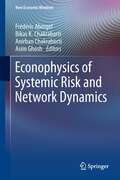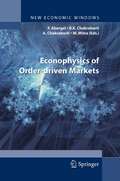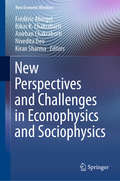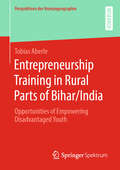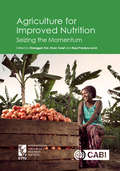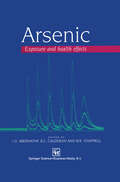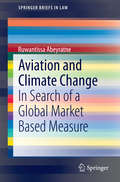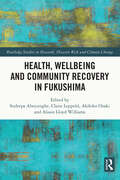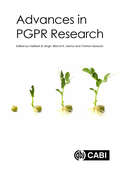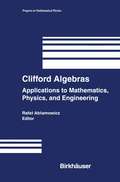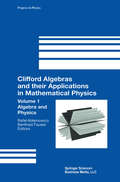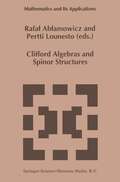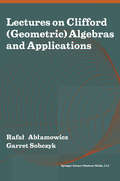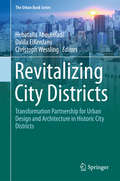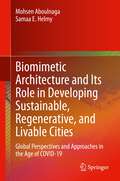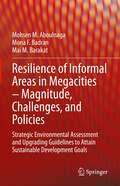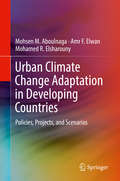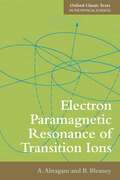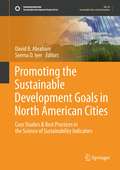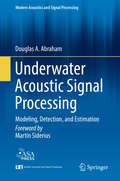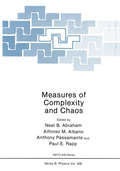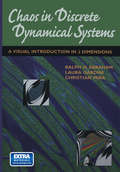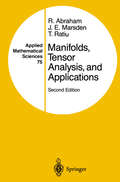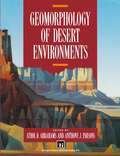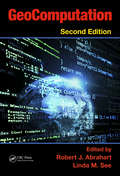- Table View
- List View
Econophysics of Systemic Risk and Network Dynamics (New Economic Windows)
by Édéric Abergel Bikas K. Chakrabarti Anirban Chakraborti Asim GhoshThe primary goal of the book is to present the ideas and research findings of active researchers such as physicists, economists, mathematicians and financial engineers working in the field of “Econophysics,” who have undertaken the task of modeling and analyzing systemic risk, network dynamics and other topics.Of primary interest in these studies is the aspect of systemic risk, which has long been identified as a potential scenario in which financial institutions trigger a dangerous contagion mechanism, spreading from the financial economy to the real economy.This type of risk, long confined to the monetary market, has spread considerably in the recent past, culminating in the subprime crisis of 2008. As such, understanding and controlling systemic risk has become an extremely important societal and economic challenge. The Econophys-Kolkata VI conference proceedings are dedicated to addressing a number of key issues involved. Several leading researchers in these fields report on their recent work and also review contemporary literature on the subject.
Econophysics of Order-driven Markets (New Economic Windows)
by Édéric Abergel Bikas K. Chakrabarti Anirban Chakraborti Manipushpak MitraThe primary goal of the book is to present the ideas and research findings of active researchers from various communities (physicists, economists, mathematicians, financial engineers) working in the field of "Econophysics", who have undertaken the task of modelling and analyzing order-driven markets. Of primary interest in these studies are the mechanisms leading to the statistical regularities ("stylized facts") of price statistics. Results pertaining to other important issues such as market impact, the profitability of trading strategies, or mathematical models for microstructure effects, are also presented. Several leading researchers in these fields report on their recent work and also review the contemporary literature. Some historical perspectives, comments and debates on recent issues in Econophysics research are also included.
New Perspectives and Challenges in Econophysics and Sociophysics (New Economic Windows)
by Frédéric Abergel Bikas K. Chakrabarti Anirban Chakraborti Nivedita Deo Kiran SharmaThis book presents the latest perspectives and challenges within the interrelated fields of econophysics and sociophysics, which have emerged from the application of statistical physics to economics and sociology. Economic and financial markets appear to be in a permanent state of flux. Billions of agents interact with each other, giving rise to complex dynamics of economic quantities at the micro and macro levels. With the availability of huge data sets, researchers can address questions at a much more granular level than was previously possible. Fundamental questions regarding the aggregation of actions and information and the coordination, complexity, and evolution of economic and financial networks are currently receiving much attention in the econophysics research agenda. In parallel, the sociophysics literature has focused on large-scale social data and their interrelations. In this book, leading researchers from different communities – economists, sociologists, financial analysts, mathematicians, physicists, statisticians, and others – report on their recent work and their analyses of economic and social behavior.
Entrepreneurship Training in Rural Parts of Bihar/India: Opportunities of Empowering Disadvantaged Youth (Perspektiven der Humangeographie)
by Tobias AberleTobias Aberle examines how an entrepreneurship training helps disadvantaged youths in rural parts of Bihar, India, to cope with structural conditions that enable or constrain them. The present research reveals that young entrepreneurs can be divided into two groups: those who developed personal initiative and thus coped with limiting structural conditions very proactively, and those who solely behaved in a reactive way. For many entrepreneurs, the self-employed activity was only a Plan B, as in reality they sought for high-prestige career jobs. IFor entrepreneurship training to become a tool of empowerment, the range of training must be significantly adjusted in accordance with young trainees’ social and educational backgrounds. In addition, a functioning ecosystem for entrepreneurship education must be in place, which ensures support for individual entrepreneurs through mentorship and networks.
Agriculture for Improved Nutrition: Seizing the Momentum
by Noora-Lisa Aberman Mathew Abraham Akhter U. Ahmed Summer Allen Suresh Chandra Babu Ekin Birol Anne Bossuyt Howarth E. Bouis Kevin Chen Gerald F. Jr Olivier Ecker Dr Jessica Fanzo Aulo Gelli Julie Ghostlaw Stuart Gillespie Daniel O. Gilligan Lawrence Haddad Derek Headey Mar Maestre Hazel Malapit William Masters Ruthie Musker Nicholas Nisbett Rajul Pandya-Lorch Prabhu L Pingali Daniel J. Raiten Marie T. Ruel Amy Saltzman Zimeiyi Wang Sivan YosefAgriculture's vast potential to improve nutrition is just beginning to be tapped. New ideas, research, and initiatives developed over the past decade have created an opportunity for reimagining and redesigning agricultural and food systems for the benefit of nutrition. To support this transformation, this book reviews the latest findings, results from on-the-ground programs and interventions, and recent policy experiences from countries around the world that are bringing the agriculture and nutrition sectors closer together. Drawing on IFPRI's own work and that of the growing agriculture-nutrition community, this book strengthens the evidence base for, and expands our vision of, how agriculture can contribute to nutrition. Chapters cover an array of issues that link agriculture and nutrition, including food value chains, nutrition-sensitive programs and policies, government policies, and private sector investments. By highlighting both achievements and setbacks, Agriculture for Improved Nutrition seeks to inspire those who want to scale up successes that can transform food systems and improve the nutrition of billions of people. Key features: -Investigates the latest evidence on the relationship between agriculture and nutrition. -Includes insights from internationally renowned researchers. -Presents data from real-world settings that is highly relevant to the challenges faced by developing countries. This book is ideal for policy-makers, practitioners, and students working in agriculture, international development and nutrition.
Arsenic: Exposure and Health Effects
by Charles O. Abernathy Rebecca L. Calderon Willard R. ChappellThe Society of Environmental Geochemistry and Health (SEGH) Second International Conference on Arsenic Exposure and Health Effects was held June 12-14, 1995 in San Diego, California. The conference was at tended by 152 people who heard 41 presentations on all aspects of arsenic research. The speakers represented 14 countries. Approximately 40 of the participants and speakers were from countries other than the US. The participants represented government, academia, industry and the interested public. The sponsorship ofthe conference is a good indicationofthe wide spread interest in the subject and the meeting. The sponsors, in addition to SEGH, were the US Environmental Protection Agency (US EPA), the Agency for Toxic Substances and Disease Registry (ATSDR), the Atlantic Richfield Company (ARCO), the Electric Power Research Institute (EPRI), the American Water Works Association Research Foundation (AWWARF), Kennecott Corporation, the American Smelting and Refining Company (ASARCO), and the International Council on Metals in the Environment (ICME). The funding was split approximately equally between industry (including industrial organizations such as EPRI) and government. In addition to the many fine presentations, the meeting provided a forum for scientists from different countries to compare experiences and share information. It also provided a forum for the discussion of both scientific and policy issues between representatives of various governmental bodies (at the local, state, and federal level) and representatives of various indus trial organizations. These discussions occurred both in the formal meetings and informal settings during the meeting.
Aviation and Climate Change: In Search of a Global Market Based Measure (SpringerBriefs in Law)
by Ruwantissa AbeyratneThe book addresses the most critical issue faced by aviation and climate change: namely the development of a market based measure to control aircraft engine emissions. It discusses the current market economic trends as they impact to aviation and suggests steps and measures to be taken in the development of a workable MBM. ICAO has three years to come up with such an MBM on a global scale and this book will spur discussions on how to achieve this objective.
Health, Wellbeing and Community Recovery in Fukushima (Routledge Studies in Hazards, Disaster Risk and Climate Change)
by Sudeepa Abeysinghe Alison Lloyd Williams Claire Leppold Akihiko OzakiThis book examines the issue of disaster recovery in relation to community wellbeing and resilience, exploring the social, political, demographic and environmental changes in the wake of the 2011 Fukushima disaster. The contributors reflect on the Fukushima disaster of earthquake, tsunami and radiation contamination and its impacts on society from an interdisciplinary perspective of the social sciences, critical public health, and the humanities. It focuses on four aspects, which form the sections of the work: Living with Risk and Uncertainty Vulnerability and Inequality Community Action, Engagement and Wellbeing Notes from the Field The first three sections present research on the long-term consequences of the disaster on community health and wellbeing. These findings are enhanced and developed in the ‘Notes from the Field’ section where local practitioners from medicine and community recovery reflect on their experiences in relation to concepts developed in the previous sections. This work significantly extends the literature on long-term wellbeing following disaster. The case study of Fukushima is a multi-faceted process that illuminates wider issues around post-disaster regeneration in Fukushima. This problem takes on new importance in the context of Covid-19, including direct parallels in the issues of risk measurement, social inequality, and wider wellbeing impacts, which public health disciplines can draw from.
Advances in PGPR Research
by P. C. Abhilash Betina Cecilia Agaras Gautam Anand Laith K. Al-Ani Fabiola Padilla Arizmendi Fatima Berenice Salazar-Badillo Mansi Bakshi E. J. Bedmar Adrien Biessy Virendra S. Bisaria Kartikay Bisen Marieta Marin Bruzos Jesús Salvador López-Bucio Jose López-Bucio Randy Ortiz-Castro Jorge Armando Mauricio-Castillo Vasvi Chaudhry Niladri Chaudhry Manoj Kumar Chitara Pooja Choudhary Manish Kumar Dubey Pradeep Kumar Dubey Rama Kant Dubey Sheikh Adil Edirisi Martin Filion Elisabetta Franchi Deepika Goyal Natalia Cripps-Guazzone Robert Hill Antonio Castellano-Hinojosa Angela Cristina Ikeda María Fernanda Nieto-Jacobo Madhu Kamle Diwakar Kandula Dr Chetan Keswani Gagan Kumar Punam Kumari Richard Daniel Lally Robert Lawry Guillermo Nogueira-López Anupam Maharshi Shrikant S. Mantri Rafael Jorge Marcillo Dmitri V. MavrodiRhizosphere biology is approaching a century of investigations wherein growth-promoting rhizomicroorganisms (PGPR) have attracted special attention for their ability to enhance productivity, profitability and sustainability at a time when food security and rural livelihood are a key priority. Bio-inputs - either directly in the form of microbes or their by-products - are gaining tremendous momentum and harnessing the potential of agriculturally important microorganisms could help in providing low-cost and environmentally safe technologies to farmers.One approach to such biologically-based strategies is the use of naturally occurring products such as PGPR. Advances in PGPR Research explores recent developments and global issues in biopesticide research, presented via extended case studies and up-to-date coverage of: · Low input biofertilizers and biofungicides used for sustainable agriculture. · Molecular techniques to enhance efficacy of microbial inputs. · Intellectual property issues in PGPR research. Written by an international team of experts, this book considers new concepts and global issues in biopesticide research and evaluates the implications for sustainable productivity. It is an invaluable resource for researchers in applied agricultural biotechnology, microbiology and soil science, and also for industry personnel in these areas.
Clifford Algebras: Applications to Mathematics, Physics, and Engineering (Progress in Mathematical Physics #34)
by Rafal AblamowiczThe invited papers in this volume provide a detailed examination of Clifford algebras and their significance to analysis, geometry, mathematical structures, physics, and applications in engineering. While the papers collected in this volume require that the reader possess a solid knowledge of appropriate background material, they lead to the most current research topics. With its wide range of topics, well-established contributors, and excellent references and index, this book will appeal to graduate students and researchers.
Clifford Algebras and their Applications in Mathematical Physics: Volume 1: Algebra and Physics (Progress in Mathematical Physics #18)
by Rafal Ablamowicz Bertfried FauserThe plausible relativistic physical variables describing a spinning, charged and massive particle are, besides the charge itself, its Minkowski (four) po sition X, its relativistic linear (four) momentum P and also its so-called Lorentz (four) angular momentum E # 0, the latter forming four trans lation invariant part of its total angular (four) momentum M. Expressing these variables in terms of Poincare covariant real valued functions defined on an extended relativistic phase space [2, 7J means that the mutual Pois son bracket relations among the total angular momentum functions Mab and the linear momentum functions pa have to represent the commutation relations of the Poincare algebra. On any such an extended relativistic phase space, as shown by Zakrzewski [2, 7], the (natural?) Poisson bracket relations (1. 1) imply that for the splitting of the total angular momentum into its orbital and its spin part (1. 2) one necessarily obtains (1. 3) On the other hand it is always possible to shift (translate) the commuting (see (1. 1)) four position xa by a four vector ~Xa (1. 4) so that the total angular four momentum splits instead into a new orbital and a new (Pauli-Lubanski) spin part (1. 5) in such a way that (1. 6) However, as proved by Zakrzewski [2, 7J, the so-defined new shifted four a position functions X must fulfill the following Poisson bracket relations: (1.
Clifford Algebras and Spinor Structures: A Special Volume Dedicated to the Memory of Albert Crumeyrolle (1919–1992) (Mathematics and Its Applications #321)
by Rafal Ablamowicz P. LounestoThis volume is dedicated to the memory of Albert Crumeyrolle, who died on June 17, 1992. In organizing the volume we gave priority to: articles summarizing Crumeyrolle's own work in differential geometry, general relativity and spinors, articles which give the reader an idea of the depth and breadth of Crumeyrolle's research interests and influence in the field, articles of high scientific quality which would be of general interest. In each of the areas to which Crumeyrolle made significant contribution - Clifford and exterior algebras, Weyl and pure spinors, spin structures on manifolds, principle of triality, conformal geometry - there has been substantial progress. Our hope is that the volume conveys the originality of Crumeyrolle's own work, the continuing vitality of the field he influenced, and the enduring respect for, and tribute to, him and his accomplishments in the mathematical community. It isour pleasure to thank Peter Morgan, Artibano Micali, Joseph Grifone, Marie Crumeyrolle and Kluwer Academic Publishers for their help in preparingthis volume.
Lectures on Clifford (Geometric) Algebras and Applications
by Rafal Ablamowicz Garret SobczykThe subject of Clifford (geometric) algebras offers a unified algebraic framework for the direct expression of the geometric concepts in algebra, geometry, and physics. This bird's-eye view of the discipline is presented by six of the world's leading experts in the field; it features an introductory chapter on Clifford algebras, followed by extensive explorations of their applications to physics, computer science, and differential geometry. The book is ideal for graduate students in mathematics, physics, and computer science; it is appropriate both for newcomers who have little prior knowledge of the field and professionals who wish to keep abreast of the latest applications.
Revitalizing City Districts: Transformation Partnership for Urban Design and Architecture in Historic City Districts (The Urban Book Series)
by Hebatalla Abouelfadl Dalila ElKerdany Christoph WesslingThis book explores the consequences of change in the urban form, the amalgam of the urban space and buildings and on the processes leading to planning and design. Urban form and its fabric result from a multitude of individual interests, ideas and decisions which in turn result in specific and locally diverse spatial arrangements. These processes which are shaping our built environment are embedded in and determined by different contexts of political, cultural and social-economic norms and values. Urban development and the transformation of urban structures are triggered by technological innovations, laws and taxes, new behaviors or the impact of environmental conditions as well as other factors. Based on case studies from Egypt and the Middle East, together with some cases from Germany and Turkey, this book covers a wide range of change processes focused on historic and inner city districts.
Biomimetic Architecture and Its Role in Developing Sustainable, Regenerative, and Livable Cities: Global Perspectives and Approaches in the Age of COVID-19
by Mohsen Aboulnaga Samaa E. HelmyThis book focuses on understanding biomimetic architecture and its role as a sustainable design tool. It presents the role of biomimicry in mitigation and adaptation to climate change and examines how biomimetic architecture can provide healthy solutions to limit the spread of COVID-19 in buildings and cities. Coverage includes global examples of biomimetic approaches and buildings, an evaluation of the performance of biomimicry applications in architecture to illustrate best practices, and an exploration of how nature can offer inspiration in building design to conserve resources and save energy use as well as curb carbon emissions – a reaffirmed goal of COP 26 and an outcome of Glasgow Climate Pact. Finally, the book presents guidelines to enhance urban areas and healthier spaces in buildings to meet COVID-19 social distance regulations and beyond.Examines global applications of biomimicry in architecture;Highlights the importance of biomimicry in driving livability in cities and buildings;Explores the role of biomimetic architecture in mitigating climate change.“The line of argument developed is highly relevant to the present, in addition to being original and pertinent to research on urban regeneration, especially in regard to the exploration of the use of biomimicry architecture in response to changing urban demands.” —Alessandra Battisti, Ph.D., Professor of Architecture, University of Rome La Sapienza-
Resilience of Informal Areas in Megacities – Magnitude, Challenges, and Policies: Strategic Environmental Assessment and Upgrading Guidelines to Attain Sustainable Development Goals
by Mohsen M. Aboulnaga Mona F. Badran Mai M. BarakatThis book focuses on the socio-economic and sustainability challenges facing megacities in dealing with the dramatic population increases of informal areas and settlements (or slums), especially when coupled with the impacts and risks of climate change. The authors examine informal urban areas globally and in developing countries utilizing strategic environmental assessment (SEA) as a tool to solve the sequence of upgrading steps concerning slums and shanty towns, and also establish essential guidelines for local governments and stakeholders to create a balance and quality of life for slums dwellers, particularly in the age of the COVID-19 pandemic, through applying sustainability indicators that enhance the upgrading process. Coverage includes recent statistics and mapping of informal areas worldwide and assessment of the GIZ and Sir Norman Foster models in terms of energy demands and consequential emission of CO2 and air pollution from slums. Three models of Maspero’s Triangle are also studied and assessed. The book is essential reading for a wide range of researchers, students, policymakers, governments, and professionals as well as a good source for research centers and academicians working in energy, climate change, urban environments, and sustainable urban development.
Urban Climate Change Adaptation in Developing Countries: Policies, Projects, and Scenarios
by Mohsen M. Aboulnaga Amr F. Elwan Mohamed R. ElsharounyThis book describes the risks, impacts, measures, actions and adaptation policies that have developed globally as a result of the severe impacts of global climate change. In-depth chapters focus on climate change assessment (CCA) in terms of vulnerabilities and reflection on the built environment and measures and actions for infrastructure and urban areas. Adaptation actions specific to developing countries such as Egypt are presented and illustrated. Global Climate change adaptation projects (CCAPs) in developing countries, in terms of their targets and performance, are presented and compared with those existing CCAPs in Egypt to draw learned lessons. Climate change scenarios 2080 using simulations are portrayed and discussed with emphasis on a case-study model from existing social housing projects in hot-arid urban areas in Cairo; in an effort to put forward an assessment and evaluation of current CCA techniques. This book helps researchers realize the global impacts of climate change on the built environment and economic sectors, and enhances their understanding of current climate change measures, actions, policies, projects and scenarios.Reviews and illustrates the impact of global climate change risks;Provides an understanding of global climate change risks in seven continents;Illustrates policies and action plans implemented at the global level and developing countries' level;Discusses climate change assessment and vulnerabilities with emphasis on urban areas;Presents measures and action plans to mitigate climate change scenarios by 2080.
Electron Paramagnetic Resonance of Transition Ions (Oxford Classic Texts in the Physical Sciences)
by A. Abragam B. BleaneyThis book is a reissue of a classic Oxford text, and provides a comprehensive treatment of electron paramagnetic resonance of ions of the transition groups. The emphasis is on basic principles, with numerous references to publications containing further experimental results and more detailed developments of the theory. An introductory survey gives a general understanding, and a general survey presents such topics as the classical and quantum resonance equations, the spin-Hamiltonian, Endor, spin-spin and spin-lattice interactions, together with an outline of the known behaviour of ions of each of the five transition groups, at the experimentalist's level. Finally a theoretical survey, using group theory and symmetry properties, discusses the fundamentals of the theory of paramagnetism.
Promoting the Sustainable Development Goals in North American Cities: Case Studies & Best Practices in the Science of Sustainability Indicators (Sustainable Development Goals Series)
by David B. Abraham Seema D. IyerThis volume presents North American best practices and perspectives on developing, managing and monitoring indicators to track development progress towards the Sustainable Development Goals (SDGs) in local communities and cities. In 4 main sections, the book presents and frames the many ways in which community indicator programs are either integrating or retooling to integrate the SDGs into their existing frameworks, or how they are developing new programs to track and report progress on the SDGs. This is the first volume that focuses on SDG adoption within the context of North Americans cities and communities, and the unique issues and opportunities prevalent in these settings. The chapters are developed by experienced academics and practitioners of community planning and sustainable development, and will add broad perspective on public policy, organizational management, information management and data visualization. This volume presents a case-study approach to chapters, offering lessons that can be used by three main audiences: 1) teachers and researchers in areas of urban, regional, and environmental planning, urban development, and public policy; 2) professional planners, decision-makers, and urban managers; and 3) sustainability activists and interested groups.
Underwater Acoustic Signal Processing: Modeling, Detection, and Estimation (Modern Acoustics and Signal Processing)
by Douglas A. AbrahamThis book provides comprehensive coverage of the detection and processing of signals in underwater acoustics. Background material on active and passive sonar systems, underwater acoustics, and statistical signal processing makes the book a self-contained and valuable resource for graduate students, researchers, and active practitioners alike. Signal detection topics span a range of common signal types including signals of known form such as active sonar or communications signals; signals of unknown form, including passive sonar and narrowband signals; and transient signals such as marine mammal vocalizations. This text, along with its companion volume on beamforming, provides a thorough treatment of underwater acoustic signal processing that speaks to its author’s broad experience in the field.
Measures of Complexity and Chaos (Nato Science Series B: #208)
by Neal B. Abraham Alfonso M. Albano Anthony Passamante Paul RappThis volume serves as a general introduction to the state of the art of quantitatively characterizing chaotic and turbulent behavior. It is the outgrowth of an international workshop on "Quantitative Measures of Dynamical Complexity and Chaos" held at Bryn Mawr College, June 22-24, 1989. The workshop was co-sponsored by the Naval Air Development Center in Warminster, PA and by the NATO Scientific Affairs Programme through its special program on Chaos and Complexity. Meetings on this subject have occurred regularly since the NATO workshop held in June 1983 at Haverford College only two kilometers distant from the site of this latest in the series. At that first meeting, organized by J. Gollub and H. Swinney, quantitative tests for nonlinear dynamics and chaotic behavior were debated and promoted [1). In the six years since, the methods for dimension, entropy and Lyapunov exponent calculations have been applied in many disciplines and the procedures have been refined. Since then it has been necessary to demonstrate quantitatively that a signal is chaotic rather than it being acceptable to observe that "it looks chaotic". Other related meetings have included the Pecos River Ranch meeting in September 1985 of G. Mayer Kress [2) and the reflective and forward looking gathering near Jerusalem organized by M. Shapiro and I. Procaccia in December 1986 [3). This meeting was proof that interest in measuring chaotic and turbulent signals is widespread.
Chaos in Discrete Dynamical Systems: A Visual Introduction in 2 Dimensions
by Ralph Abraham Laura Gardini Christian MiraThe materials in the book and on the accompanying disc are not solely developed with only the researcher and professional in mind, but also with consideration for the student: most of this material has been class-tested by the authors. The book is packed with some 100 computer graphics to illustrate the material, and the CD-ROM contains full-colour animations tied directly to the subject matter of the book itself. The cross-platform CD also contains the program ENDO, which enables users to create their own 2-D imagery with X-Windows. Maple scripts are provided to allow readers to work directly with the code from which the graphics in the book were taken.
Manifolds, Tensor Analysis, and Applications (Applied Mathematical Sciences #75)
by Ralph Abraham Jerrold E. Marsden Tudor RatiuThe purpose of this book is to provide core material in nonlinear analysis for mathematicians, physicists, engineers, and mathematical biologists. The main goal is to provide a working knowledge of manifolds, dynamical systems, tensors, and differential forms. Some applications to Hamiltonian mechanics, fluid me chanics, electromagnetism, plasma dynamics and control thcory arc given in Chapter 8, using both invariant and index notation. The current edition of the book does not deal with Riemannian geometry in much detail, and it does not treat Lie groups, principal bundles, or Morse theory. Some of this is planned for a subsequent edition. Meanwhile, the authors will make available to interested readers supplementary chapters on Lie Groups and Differential Topology and invite comments on the book's contents and development. Throughout the text supplementary topics are given, marked with the symbols ~ and {l:;J. This device enables the reader to skip various topics without disturbing the main flow of the text. Some of these provide additional background material intended for completeness, to minimize the necessity of consulting too many outside references. We treat finite and infinite-dimensional manifolds simultaneously. This is partly for efficiency of exposition. Without advanced applications, using manifolds of mappings, the study of infinite-dimensional manifolds can be hard to motivate.
Geomorphology of Desert Environments
by Athol D. Abrahams Anthony J. ParsonsOver the last twenty years there has been a major expansion of knowledge in the field of landforms and landforming processes of deserts. This advanced-level book provides a benchmark for the current state of science, and is written by an international team of authors who are acknowledged experts in their fields.
GeoComputation
by Robert J. Abrahart Linda M. SeeA revision of Openshaw and Abrahart's seminal work, GeoComputation, Second Edition retains influences of its originators while also providing updated, state-of-the-art information on changes in the computational environment. In keeping with the field's development, this new edition takes a broader view and provides comprehensive coverage across the
